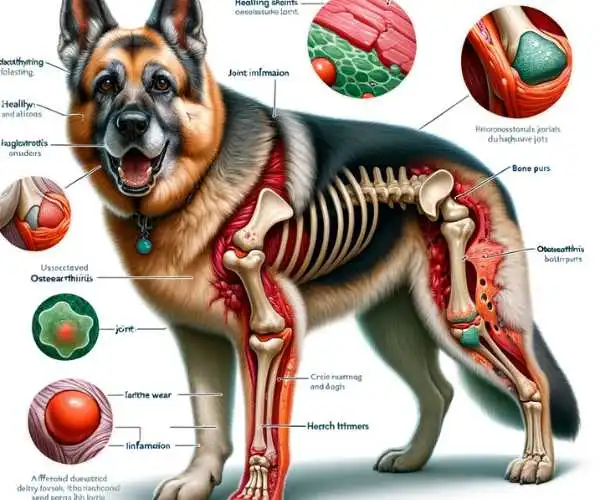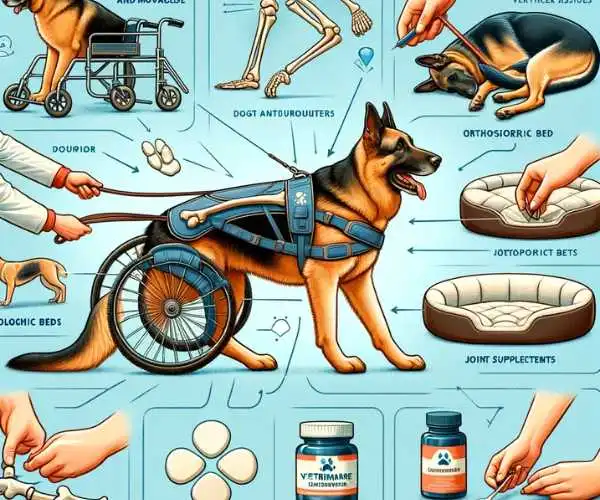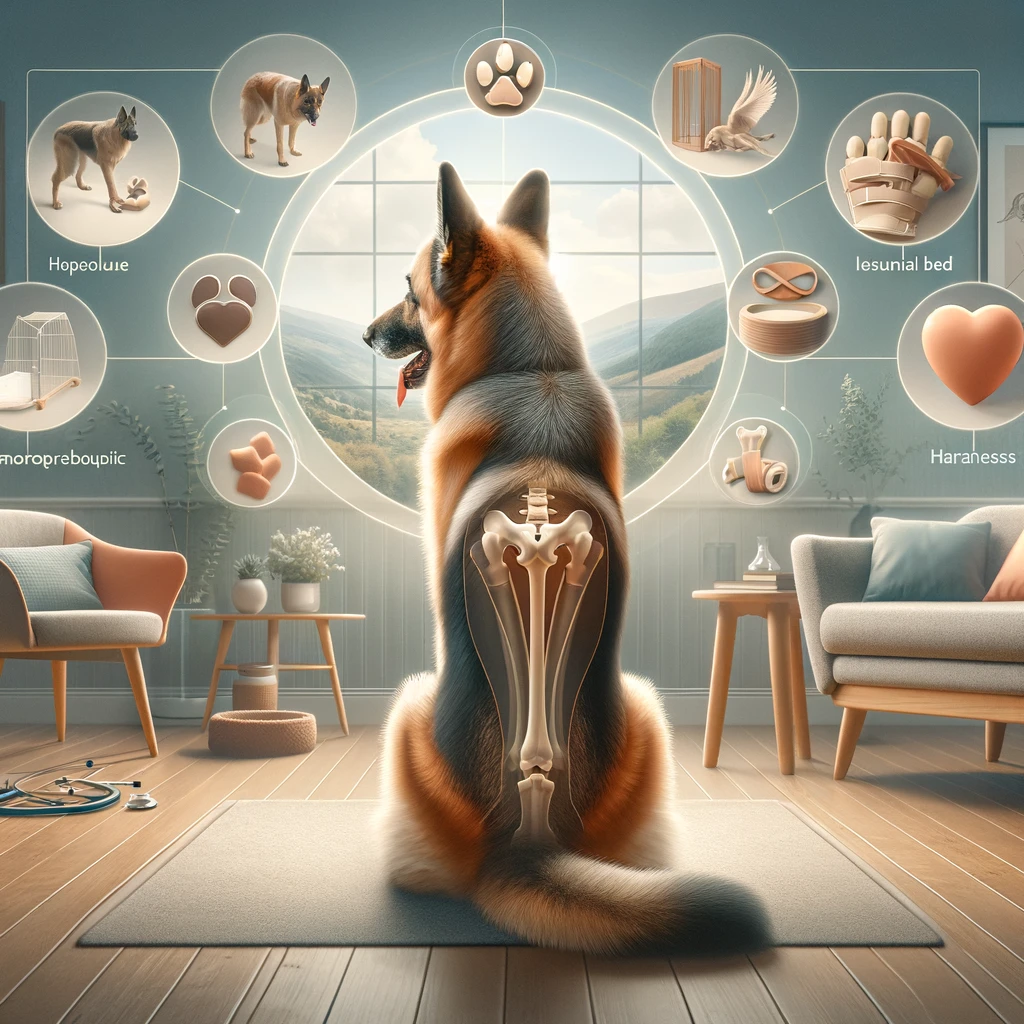As someone passionate about the well-being of dogs, mainly German Shepherds, I’ve observed that they can face various mobility challenges as they enter their older years. German Shepherd health problems with back legs are especially prevalent in this breed and warrant extra attention and care.
As these majestic animals age, the wear and tear on their joints can significantly affect their ability to perform routine daily activities. This can lead to changes in their mood and appetite, ultimately impacting their overall quality of life. In this article, we’ll dive deeper into the typical back leg problems that plague German Shepherds and offer ways for owners to help manage their faithful companion’s condition.
Why are German Shepherds’ back legs prone to problems?
One of the most heartbreaking German Shepherd’s health problems and leg conditions is degenerative myelopathy, a progressive spinal cord issue that affects older dogs. This disease can strip a German Shepherd of its hind leg function, often manifesting as weakness in the back legs that can worsen to the point where the dog can’t walk.
Alongside degenerative myelopathy, hip dysplasia and osteoarthritis are also prevalent, leading to pain, stiffness, and reduced mobility. These joint conditions are why a properly balanced diet and exercise are pivotal in managing a German Shepherd’s back leg health. Additionally, massage can be a therapeutic way to relieve fatigue and pain, comforting our noble companions when they suffer from these common problems.

Are these diseases particularly prevalent in German Shepherds with health problems with their back legs?
| Disease | Description | Common Symptoms | Treatment Options |
| Hip Dysplasia | genetic condition causing improper hip joint formation, leading to arthritis. | Limping, difficulty rising, and reluctance to run or jump. | Weight management, anti-inflammatory medications, physical therapy, and surgery in severe cases. |
| Degenerative Myelopathy | A progressive spinal cord disease leading to paralysis of the back legs. | Weakness in the back legs, difficulty walking, paralysis. | There is no cure, but supportive care can help maintain a good quality of life. |
| Panosteitis | inflammation of the long bones in the legs, known as “growing pains.” | Limping, pain when touching the affected leg. | Pain management typically resolves as the dog matures. |
| Cauda Equina Syndrome | It affects the nerve roots near the tail end of the spinal cord, causing pain and difficulty in movement. | Pain, lameness, and difficulty standing or walking. | Anti-inflammatory medications, physical therapy, and surgery in severe cases. |
| Cruciate Ligament Tear | Tear in one of the knee joint’s ligaments, leading to lameness and pain. | Sudden lameness in one leg, swelling around the knee. | Rest, anti-inflammatory medications, and surgery, depending on severity. |
German Shepherds are distinctively recognized for their firm, muscular construct, and iconic stance, wherein their hind legs seem more bent than the ones of an ordinary dog. This isn’t merely a beauty distinction but a trait deliberately bred into them, precisely due to breed requirements set with the aid of companies and the American Kennel Club (AKC). The requirements prefer a steeper angulation inside the hindquarters, with a few dogs showing nearly a 90-degree bend at the hock.
While this particular angulation contributed to the breed’s powerful gait and became traditionally valued for operating roles, it can cause multiplied wear and tear on the joints. This structure makes German Shepherds vulnerable to critical leg troubles as they age. Studies have shown that German Shepherds are 5 times more likely to expand hip dysplasia than breeds like Labradors, Rottweilers, and Golden Retrievers due to the steeper perspective in their hocks, which places extra strain at the knee because it connects with the ground. Through the years, this stress can exacerbate joint problems, leading to aches and other hind leg complications.
Degenerative Myelopathy
Degenerative myelopathy (DM) is a debilitating neurological disease that is unfortunately quite common in German Shepherds. It typically occurs in older dogs, often around eight years of age, although it can sometimes emerge at a younger age. An estimated 2% of German Shepherds are affected by DM, a condition characterized by a gradual loss of control over their hind legs.
As the disease progresses, affected dogs may also lose urinary and bowel functions and eventually develop paralysis. I’m sorry, I didn’t understand what you meant. You repeated the exact text you asked me to rewrite earlier. Please provide me with more context or information so that I can assist you better. There, owners can take steps to reduce their GSD’s suffering as the condition advances.
Treatment options are primarily aimed at maintaining quality of life. Under vet supervision, regular exercise can help preserve muscle strength and mobility for as long as possible. Unfortunately, most dogs with DM will lose function within six months to two years following their diagnosis. Owners must work closely with their veterinarians to provide their dogs with the care and support they need during this challenging time.
Hip Dysplasia
Hip dysplasia is a concerning joint disease that often besieges German Shepherds, particularly affecting their back legs. In a fit and healthy dog, the hip joint ball glides smoothly within the socket. However, this ball and socket do not fit snugly for those with hip dysplasia, causing the bone to rub and grind rather than slide smoothly. This can result in the joint wearing down over time, leading to pain and difficulty in movement. Owners might notice telltale signs such as a wobbly gait, lameness or limping, and a decreased range of motion when the dog is walking.
The common causes of hip dysplasia are multifold, often rooted in genetics, but can also be aggravated by leg trauma and certain environmental factors. Treatment options vary depending on the dog’s age and the severity of the joint misalignment. In extreme cases, the dog may lose function in the affected leg and require a wheelchair for support. Interventions aim to lessen the pressure on the hips and make walking, running, and playing more accessible for the German Shepherd. This can include controlled exercise, weight management, anti-inflammatory medications, physical therapy, and surgical correction in some severe cases.
Osteoarthritis
Osteoarthritis is a progressive disease that has a profound impact on the well-being of German Shepherds. Over time, the cartilage in a dog’s joints begins to degenerate, particularly as they age, leading to arthritis—painful joint inflammation and stiffness.
With their predisposition for hip dysplasia, GSDs are pretty prone to developing osteoarthritis, often presenting with hind leg weakness and an increased risk for severe arthritis if they have a history of bad hips. The characteristic bent shape of German Shepherd legs can exacerbate the pressure on their hip joint and significantly contribute to this condition.
Signs that a German Shepherd might be grappling with arthritic joints can include a change in their gait, where they attempt to walk with their body lower to the ground to lessen the pain. Other indicators may be lethargy, loss of muscle mass in the hind limbs, and a reluctance to run, jump, or navigate a flight of stairs. Stiffness after a rest may also be evident.

Helping your German Shepherd’s back legs stay healthy.
Preventing hereditary conditions is paramount to safeguarding German Shepherds’ mobility and health. Responsible breeding practices play a crucial role in this endeavor. By adhering to good breeding standards, breeders can select parent dogs cleared of prevalent diseases like hip dysplasia and degenerative myelopathy through genetic testing. Paying close attention to the hip score, which assesses the likelihood of hip dysplasia, is one measure breeders can implement to ensure healthier outcomes for the puppies.
Moreover, proper parent-child matching not only contributes to the reduction of mobility issues but also promotes the overall vitality of the breed. Prospective owners must engage with reputable breeders who prioritize the dogs’ health over aesthetics or lineage prestige.
By demanding transparency in genetic testing and breeding practices, owners can avoid the heartache of these debilitating diseases and provide a more wholesome life for their German Shepherds.
Diet
A healthy diet is a cornerstone in preventing and managing German Shepherd health problems related to the back and legs. Given that German Shepherds are a large breed prone to joint and bone issues, maintaining their optimal weight is paramount. This helps mitigate the strain on their hind legs and protects against their genetics’ unpredictable effects on their well-being. Observing a healthy and balanced dietary regimen is imperative.
While selecting dietary options, it’s essential to include high-quality proteins, suitable amounts of vitamin D for bone strength, and vitamin K, magnesium, vitamin C, and vitamin E for their anti-inflammatory properties. When choosing dog food, make sure it is well-suited for German Shepherds, taking into account the appropriate balance of calcium and phosphorus for healthy bone development.
Always consult a vet to ensure proper portioning and balance of nutrients that may change over time based on the dog’s age, weight, and overall health. Depending on the individual needs of your dog, your vet may also prescribe specific bone and joint supplements containing ingredients like glucosamine, chondroitin, green-lipped mussels, and collagen, all of which are required for the support and maintenance of robust leg health in German Shepherds.
Dealing with back-leg medical conditions in dogs
Maintaining an optimal weight for a German Shepherd is crucial to averting and managing mobility challenges due to degenerative myelopathy (DM) and other back-leg conditions. An obese or overweight dog will inherently face increased strain on their hind legs, exacerbating health issues and potentially leading to more severe mobility problems over time. Regular, moderate exercise is vital. Walking and swimming are excellent low-impact aerobic movements that can strengthen the hind legs without putting undue pressure on the joints.
For German Shepherds dealing with or at risk for DM, it is essential to consult a veterinarian regularly. The vet can recommend suitable supplements and medications that might slow the progression of medical conditions. Any changes in your dog’s movement, such as a wobbly walk, slipping on the floor, sitting crookedly, hips giving way, swelling in the joints, a decrease in muscle mass in the back legs, a notably shorter stride, and any signs that they might be in pain or discomfort, should prompt immediate contact with your vet.
Spotting these symptoms early on can be invaluable in managing degenerative conditions. With early detection and treatment, providing the dog with a better quality of life is often possible. A proactive approach to recognizing and addressing health issues in German Shepherds can make a significant difference in managing the health of their back legs.
Providing Aid and Support for Dogs with Back and Leg Issues

Assistive Devices and Physical Therapy
Regular exercise
In cases where a German Shepherd has developed significant mobility challenges, assistive devices such as wheelchairs can be life-changing. These devices can provide the necessary support to maintain physical activity while reducing pressure on their back legs. For milder conditions, physical, etc.
Regular exercise
Engaging a German Shepherd in regular exercise strengthens their hind legs and fortifies the muscles in their front legs, promoting overall muscular balance and endurance. To spot changes in your dog’s performance and physical condition, it’s important to establish regular routines that challenge them without causing strain or injury.
One example of an effective routine is the sit-to-stand exercise. Begin by encouraging your German Shepherd to sit, and then, with a call or a treat to pique their interest, motivate them to stand. Repeat this several times as it targets the quads and hamstrings in the back legs and involves the full range of leg muscles in the motion. Integrating this into their daily routine can prove notably beneficial.
Incorporate daily walks that involve gentle slopes or hills, which can significantly strengthen the leg muscles while managing the dog’s weight. Swimming sessions are also excellent for dogs, as the buoyancy of the water reduces joint stress while providing resistance to strengthen muscles—a perfect exercise for German Shepherds with mobility issues. For owners with access, hydrotherapy can be an extremely beneficial addition; the controlled environment allows for targeted muscle work without the risk of injury.
Massage
can significantly benefit a German Shepherd’s hind legs by relieving fatigue and tension from regular exercise sessions. Canine massage is a gentle, therapeutic approach that aids in relaxation and identifying areas of discomfort that might go unnoticed otherwise.
First, let the dog lay down comfortably and ensure the fur is flat.
Using the flat of your hands, softly compress the muscles with gentle pressure. With your palms and fingers, slowly glide over the spine, down to the hind legs. As you reach the muscular areas of the back legs, apply semi-circular strokes to stimulate blood flow. This process helps spot any unrelated pain or discomfort that requires veterinary attention. Always be gentle and responsive to the dog’s reactions to your touch.
Using a support harness
For a German Shepherd experiencing stress on their back legs, using a support harness can be a transformative aid for mobility. These harnesses are specifically designed to redistribute pressure from their hindquarters to other parts of the body, which reduces the stress on their back muscles and relieves discomfort associated with bad back legs.
During walks, support harnesses make it easier for the dog to move and help keep their muscles strong by encouraging standard walking patterns while providing the necessary assistance. Selecting a comfortable harness that fits well is crucial to avoiding additional pressure points. For optimal benefits and safety, the harness should be used moderately and under the guidance of a veterinarian, ensuring it becomes a comfortable and supportive part of the dog’s daily routine.
To prevent potential issues, owners should be trained to use and remove the harness properly to ensure it’s a stress-free experience for their dog.
Consult Your Vet
Regular consultation with your veterinarian is the perfect opportunity to develop a list of diseases and conditions that commonly affect German Shepherds, particularly those that could compromise the dog’s hind leg strength and mobility. Degenerative myelopathy (DM), hip dysplasia, and osteoarthritis are critical conditions to be aware of. It’s important to remember that each dog is an individual and may exhibit different symptoms or progression of a disease.
By having a clear idea of potential health issues, dog owners can be vigilant and seek timely, effective treatments from a veterinarian if and when needed. Early recognition and management of these conditions can substantially improve your German Shepherd’s quality of life.
Final Thoughts
Caring for a German Shepherd’s health requires a keen understanding of the breed’s predisposition to certain conditions, especially those impacting their back. A combination of good practices is crucial to uphold their overall health, manage a healthy weight, and support robust mobility.
A GSD facing degenerative illnesses and back issues necessitates a well-explored treatment plan and supportive methods. These interventions enable a higher quality of life, leveraging the known resilience of this robust breed.
Regular exercise is a foundational aspect of preventative care, helping to battle weight gain and alleviate pressure on the spine and hind legs. As part of an inclusive health strategy, owners must appreciate the effort to ensure their dog’s well-being, from balanced nutrition to engaging in activities tailored to their physical needs. Match this with the proper health checks, and German Shepherds can continue to thrive even when challenged by back-related health problems.
FAQs
What do you do when your canine’s returned legs keep giving out?
If your dog’s legs are giving out again, it’s essential to consult a veterinarian to diagnose the cause, ranging from arthritis to severe neurological issues. They may advise treatments, including medication, physical remedies, or lifestyle changes. Ensuring your canine’s comfort and mobility should be a top priority.
Why is my German Shepherd dropping feeling in his returned legs?
Loss of feeling in the lower back legs of German Shepherds may be a symptom of degenerative myelopathy, A mistake that happened in the course of a generation. Please strive once more or contact support if it continues.
How long can a German Shepherd stay with degenerative myelopathy?
Degenerative myelopathy is a modern disorder with a variable diagnosis in German Shepherds. On average, affected puppies can stay anywhere from 6 months to three years up-analysis, depending mainly on the development of the disorder and the fine of supportive care provided. Early detection and management are critical in improving the pleasant lifestyle of a dog in this circumstance.
How long can a German Shepherd live with hip dysplasia?
The lifespan of a German Shepherd with hip dysplasia can vary widely, but it isn’t always always a death sentence. With proper management, medication, bodily therapy, and weight management management, those puppies can live quite simply for decades. The severity of the circumstance and exceptional care substantially affect their sturdiness.
